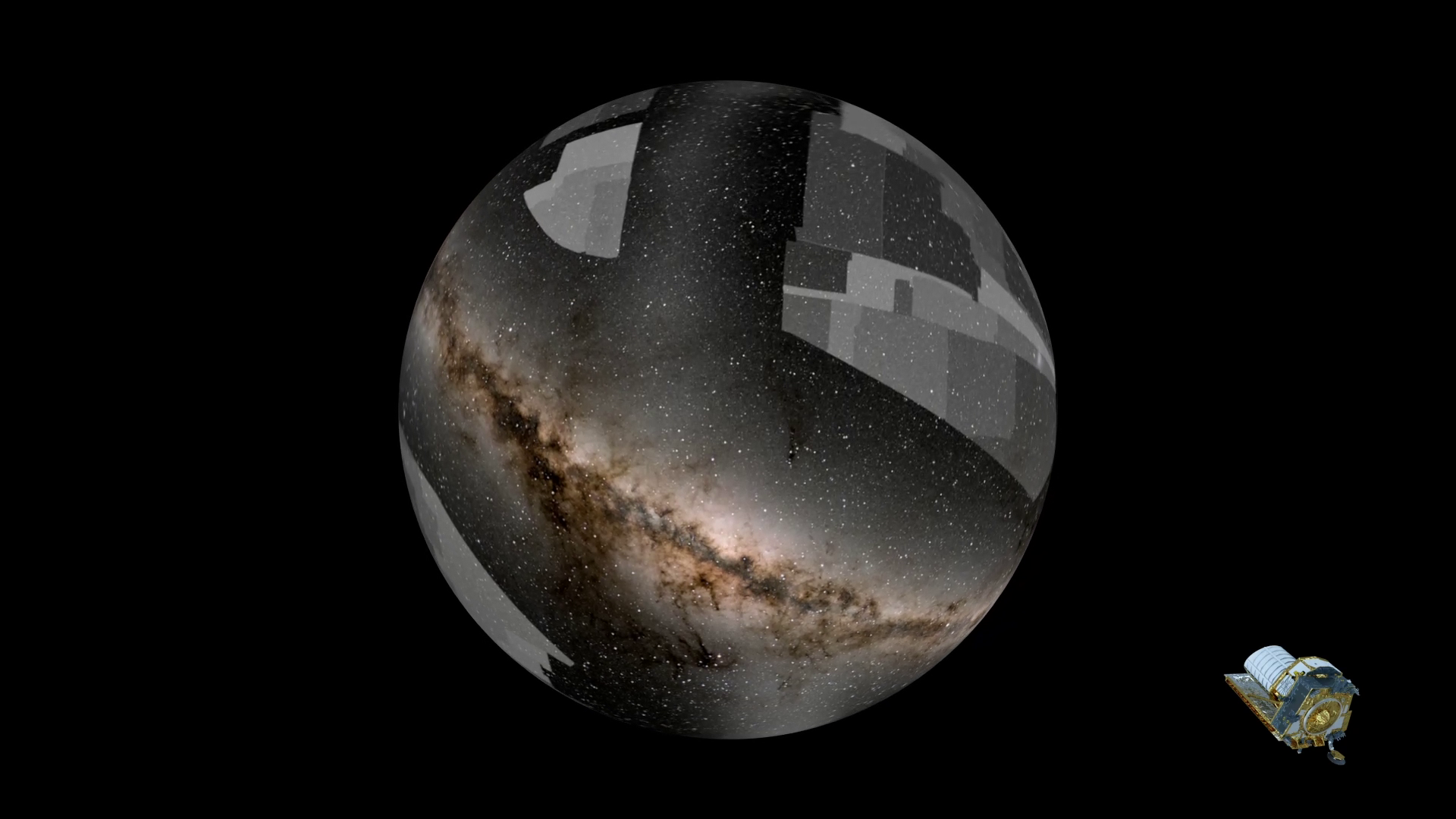Media Invitation: Euclid mission to release first full-colour images of the cosmos on 7 November
ESA’s Director of Science Carole Mundell and leading scientists from across Europe will gather at ESA’s Space Operations Centre in Darmstadt, Germany, to discuss with Media the first, razor-sharp astronomical images of the Euclid mission, looking for mysterious, dark matter and energy.
Never before has a space telescope been able to create such images across such a large patch of the sky, looking so far into the distant Universe. These images tease off Euclid's full, unique potential and show that the telescope is ready for its science mission.
They are a milestone on the way to studying some of the greatest mysteries of the Universe: Euclid will create the most extensive 3D map of the Universe, to study the invisible 95% of the Universe – Dark Matter and Dark Energy.
Media representatives are kindly invited to the European Space Operations Centre (ESA/ESOC), from where Euclid is controlled, to view and discuss these images and the world-class, astronomical science behind it. Moreover, the control rooms of this ESA-lead mission can be visited and, in a selective mode, interviews can be done in these mission control rooms.
Leading ESA experts, key members of the Euclid Science Consortium from across Europe, and beyond, as well as Industry managers will gather and are available for interviews on site, or also remotely.


Access the video
Media Programme
11:00 Security check-in / Doors open for journalists at ESA/ESOC
12:00 Pre-release interview opportunities at ESOC / Press Centre H 05
13.00 Start of Media Briefing (on site, ESOC Press Centre)
Welcome at ESA, introduction to Euclid & ESA astronomy – by Carole Mundell, ESA Director of Science
Ambitions and challenges of Euclid, looking for Dark Matter and Dark Energy – by Giuseppe Racca, Euclid Project Manager
How to fly and to operate a space telescope safely at Lagrange Point L2 – by Simon Plum, Head of ESA Mission Operations Department
Delivering unique, full-colour images from the sky, members of the Euclid Science Consortium explain:
- Francis Bernardeau (Euclid Consortium deputy lead, Institut d’Astrophysique de Paris CNRS / CEA Paris-Saclay, France)
- Knud Jahnke (Near Infrared Spectrometer and Photometer (NISP) photometry instrument scientist; Max Planck Institute for Astronomy, Heidelberg, Germany);
- Reiko Nakajima (researcher, Visible instrument (VIS), Astronomy, University of Bonn, Germany)
- Jean-Charles Cuillandre (Euclid Early Release Observations scientist, CEA Paris-Saclay, France)
- Henk Hoekstra (EC cosmology coordinator; professor; University of Leiden, Netherlands)
Further senior experts will be on site, available for comments in many languages, from: ESA Science Directorate, ESA Operations Directorate, Paolo Musi of Thales Alenia Space (Prime Industry Contractor), Jason Rhodes of NASA JPL Science, etc.
13.45 Media interview opportunities
14:15 ESA Web TV broadcast (releasing HD images world-wide, providing expert comments, followed live in Press Centre, all experts are nearby)
15:00 Post-image release Q+A session with journalists onsite and via WebEx, moderated in hybrid mode
16:00 further interview opportunities at ESOC, Press Centre and including ESA Main Control Room area (in smaller groups)
Moderator: Bernhard von Weyhe, ESA Media Relations
17:00 End of Media briefing, all external guests leaving ESOC premises
Venue for Tuesday, 7 November 2023
European Space Operations Centre (ESA/ESOC)
Robert-Bosch-Str. 5 - 64293 Darmstadt, Germany
More/how to get there: www.esa.int/esoc
Media registration
Media representatives are kindly invited to register by 18:00 CET on Friday, 3 November 2023 at the latest for on-site presence at ESA/ESOC in Darmstadt, or to receive access codes to follow remotely the Q&A session via an ESA WebEx session. Only those registered will be able to follow and ask their questions:
https://blogs.esa.int/forms/esa-media-briefing-form/
Media contacts
For further information and detailed interview coordination, please contact ESA Media Relations, present on site in Darmstadt: simona.nichiteanu@ext.esa.int / bernhard.von.weyhe@esa.int
Tel.: 0049-6151-90 2285
Further information
- Euclid mission: www.esa.int/euclid
- Euclid factsheet: https://www.esa.int/Science_Exploration/Space_Science/Euclid_overview
-
Euclid Media kit for launch (content, graphics, videos, background):
https://www.esa.int/Science_Exploration/Space_Science/Euclid/Euclid_launch_kit
Social Media
X: @ESA @Esa_Euclid - hashtags #ESAEuclid #DarkUniverse
Instagram: Europeanspaceagency
Facebook: EuropeanSpaceAgency
YouTube: ESA
LinkedIn: European Space Agency - ESA
Pinterest: European Space Agency - ESA
Images
https://www.esa.int/ESA_Multimedia/Search?SearchText=euclid
ESA's Photo Library for Professionals:
https://photolibrary.esa.int/home-page/
Terms and conditions for using ESA images:
www.esa.int/spaceinimages/ESA_Multimedia/Copyright_Notice_Images
For questions or more information related to ESA images, please contact directly spaceinimages@esa.int
Videos
https://www.esa.int/ESA_Multimedia/Search?SearchText=Euclid&result_type=videos
ESA's Video Library for Professionals:
https://www.esa.int/esatv/Videos_for_Professionals
Terms and conditions for using ESA videos:
https://www.esa.int/spaceinvideos/Terms_and_Conditions
For questions or more information related to ESA videos, please contact directly spaceinvideos@esa.int
About the European Space Agency
The European Space Agency (ESA) provides Europe’s gateway to space.
ESA is an intergovernmental organisation, created in 1975, with the mission to shape the development of Europe’s space capability and ensure that investment in space delivers benefits to the citizens of Europe and the world
ESA has 22 Member States: Austria, Belgium, the Czech Republic, Denmark, Estonia, Finland, France, Germany, Greece, Hungary, Ireland, Italy, Luxembourg, the Netherlands, Norway, Poland, Portugal, Romania, Spain, Sweden, Switzerland and the United Kingdom. Latvia, Lithuania, Slovakia and Slovenia are Associate Members.
ESA has established formal cooperation with four Member States of the EU. Canada takes part in some ESA programmes under a Cooperation Agreement.
By coordinating the financial and intellectual resources of its members, ESA can undertake programmes and activities far beyond the scope of any single European country. It is working in particular with the EU on implementing the Galileo and Copernicus programmes as well as with Eumetsat for the development of meteorological missions.
Learn more about ESA at www.esa.int


